Articles, In the Press, Resources, Yoga Medicine® News
The 3 C’s of Chair Yoga
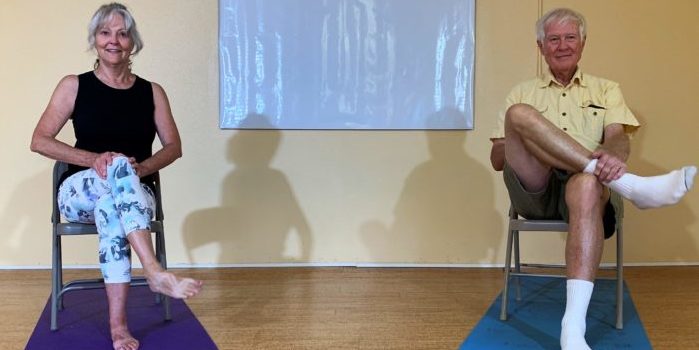
In 2008 I was fresh out of my teacher training in India and back home in rural Colorado. I came back ready to teach stressed out moms (like me) the benefits of yoga. What I found instead was a population that was in need and underserved. I met the director of the local senior center at a chamber of commerce meet and greet. She asked if I taught chair yoga and I told her no, but if she was willing to let me try, I was willing to figure it out.
This began an exploration into the adaptability of yoga for me as an able-bodied yogi and teacher. I discovered with imagination, willingness and creativity yoga can be made assessable for every BODY. Teaching chair yoga has been one of the most challenging and rewarding aspects of my teaching career. My students range in age from 60-90 years old and have many circumstances such as oxygen tanks, pacemakers, knee replacements, hip replacements, shoulder surgeries, spinal fusions, diabetes and other chronic illness. Instead of seeing them as their circumstances, I approached them compassionately and with curiosity. Working with them has provided me with an insight into the complex yet beautiful adaptability of the body and spirit.
Over the years my approach to teaching chair yoga can be boiled down to 3 C’s: community, compassion and circulation. Using this as framework, you can create a meaningful and beneficial chair yoga practice for many circumstances that people are facing. I feel like my main priority is to help my students focus on what they can do, not on what they cannot do. This has resonated deeply with my students not only physically but mentally and emotionally as well.
Community
Circle the wagons (or chairs)! This is the only class that I teach in a circle formation. This is a symbol of wholeness, community and connection. In an aging population, I find it is so important to create eye contact and to have a feeling of being a part of something bigger. We notice if our circle is smaller and we realize immediately when someone is missing and inquire about their wellbeing. We spend the first bit of class doing “mouth yoga” which is code for gabbing and catching up. This is often where I am mentally editing my class so I can meet them where they are. My care and concern is genuine. This creates a tone that carries the supportive energy throughout the entire time we are together. It elevates the mood and ties us together. Yoga, after all, means union.
This is also the only class that I teach and participate in the whole time. I want to be included in the energy of the practice and refrain from just standing up at the front to teach to a population that is much wiser and more seasoned than me. Because of so many individualized circumstances, I do not make physical adjustments. I rely on my verbal cues and demonstration to make corrections. Being in a circle helps them reference each other so they can see how the pose looks on other bodies that have challenges too. This is not meant to compare, but to see the diversity and to celebrate and support each other.
Compassion
At the beginning of practice, I set the tone for self-compassion. I have found body shaming to be a normal reference for many women in this generation. Along with that, I hear so much talk around the resistance to aging and how “it’s all downhill from here.” A disconnect with their body is often present. With deep compassion, I carefully navigate with language that helps them to consider that aging, perhaps, is a privilege instead of a curse. Many times, it is the first opportunity they have had to make room to love and care compassionately for their bodies. Compassion coupled with gratitude allows the mental practice to set the stage for the movement. When we move with loving kindness towards our body instead of angst and disapproval, it changes the quality of the movement immensely.
Circulation
Once the tone of the class is set, it is time to move. I look at promoting circulation in the entire body – especially the nooks and crannies that are not included in our “sit, stand, walk” daily patterns. You must imagine the chair as a prop and use it as such. It allows many people to still create postural strength as well as tap into the entire spectrum of movement in the body.
We start by welcoming our feet to class by spreading and lifting the toes then placing them back down. We close our eyes, lengthen our spine and breathe. Once we establish ujjayi breath, I encourage them to never sacrifice the breath for the movement or posture. The breath is primary, and the postures are secondary. There are limitless ways to sequence a class, but below is a structure that can help create circulation in a diverse group of students.
Seated ½ Sun Salutations
Each ½ of the breath shape shifts us from one pose to the next, it begins to establish the body mind connection. Do 3-5 rounds of the following:
- Inhale: arms reach overhead
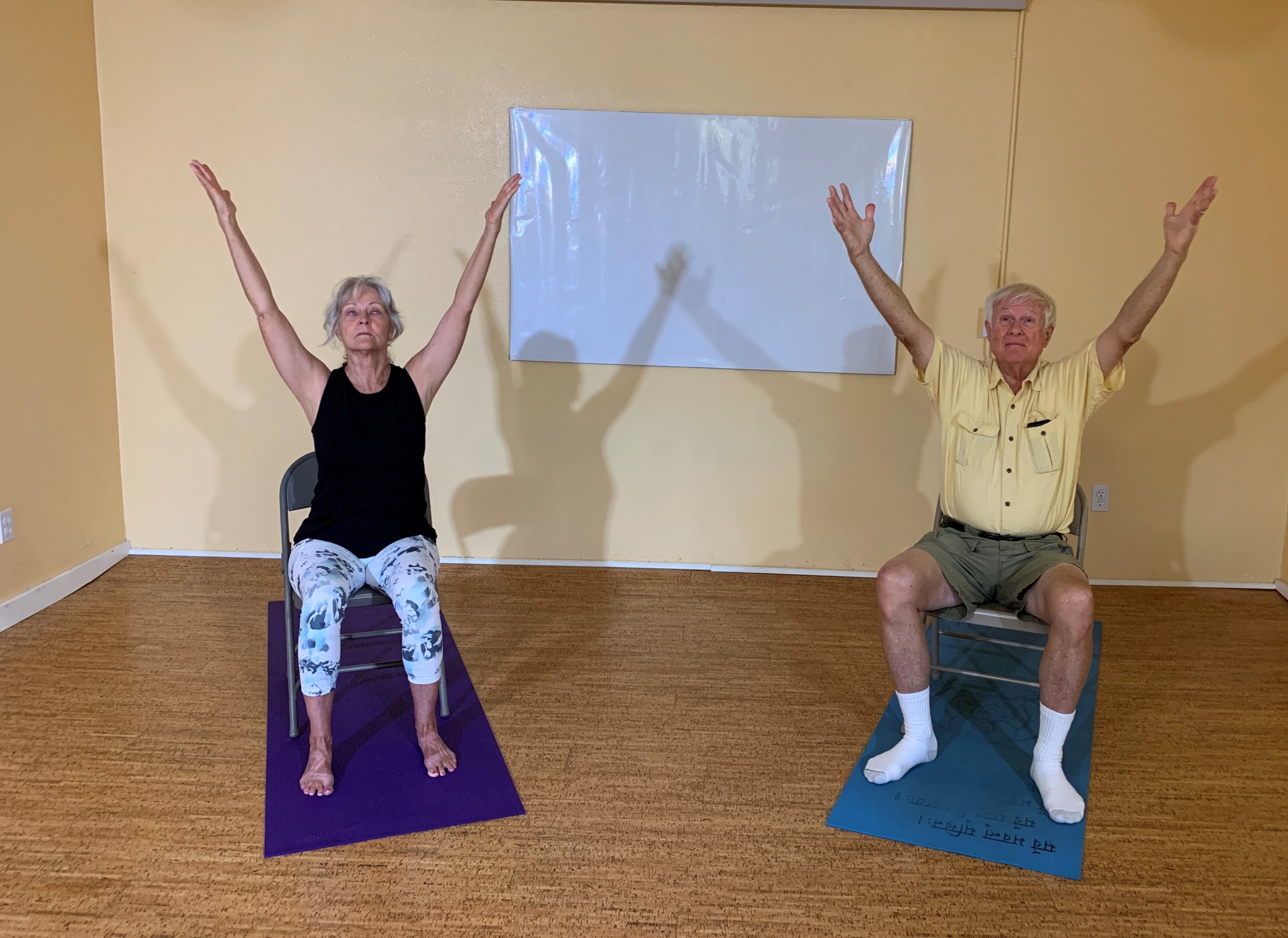
- Exhale: Uttanasana

- Inhale: ½ way lift
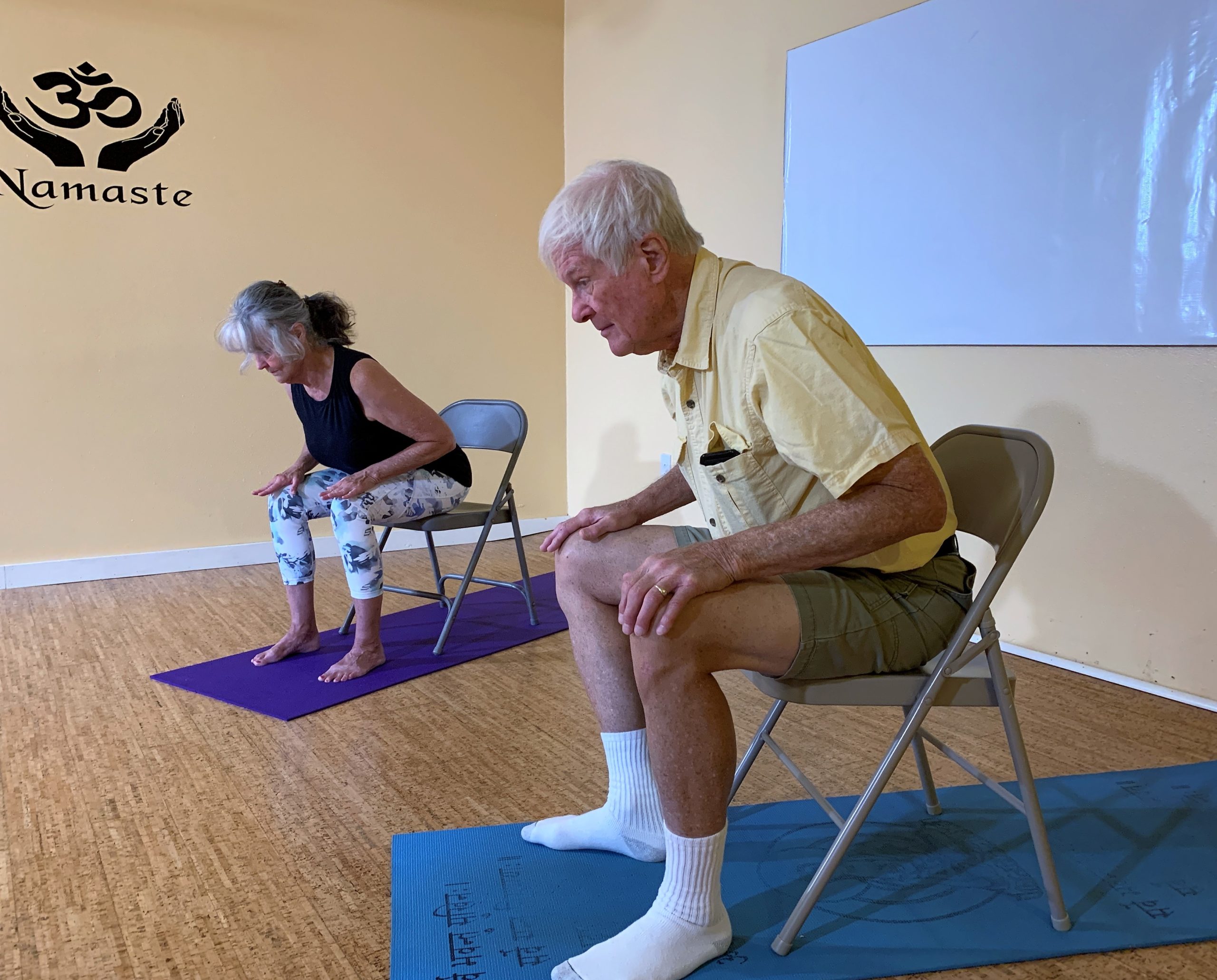
- Exhale: Uttanasana

- Inhale: rise, arms overhead
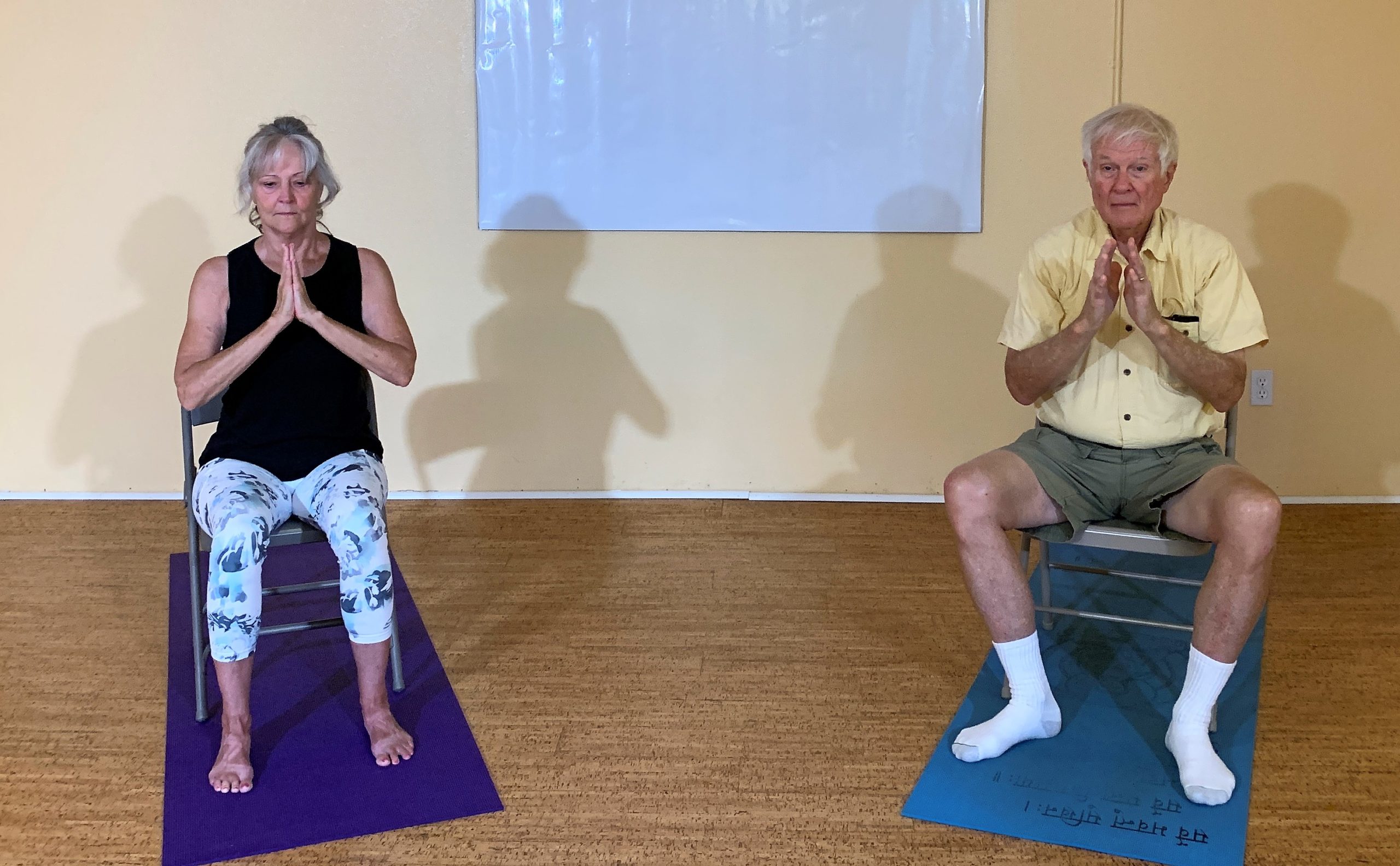
- Exhale: Hands to heart
Flexion and Extension (Better Known as Cat/Cow)
- Inhale: Cow – Stay upright as possible, rock forward of your sitting bones, squeeze shoulder blades
together and curl the sternum up as you lift the chin

- Exhale: Cat – Rock behind your sitting bones and turn your gaze in towards your navel and draw it back
towards your spine as you spread the back body wide.

Twist Right and Left
- Sit tall with knees and feet together. Take your right hand across the body to the outside of the left knee. Reach your left hand behind you to help lift the spine a little taller.
- Inhale feel the length of your spine and exhale twist your upper body to the left while keeping both sitting bones heavy and grounded
to the chair. Stay 3-5 breaths. Inhale to release and repeat on the opposite side

Lateral bend Right and Left
- Still seated in the chair, separate your feet hip distance apart and ground your sitting bones into your chair.
- Inhale both arms overhead. Your right hand grabs the left wrist and side bend to your right without unplugging your pelvis. Begin little tiny bounces to the right as you breathe smoothly and calmly. The bounces won’t match the breath necessarily. Stay 3-5 breaths and then change sides.
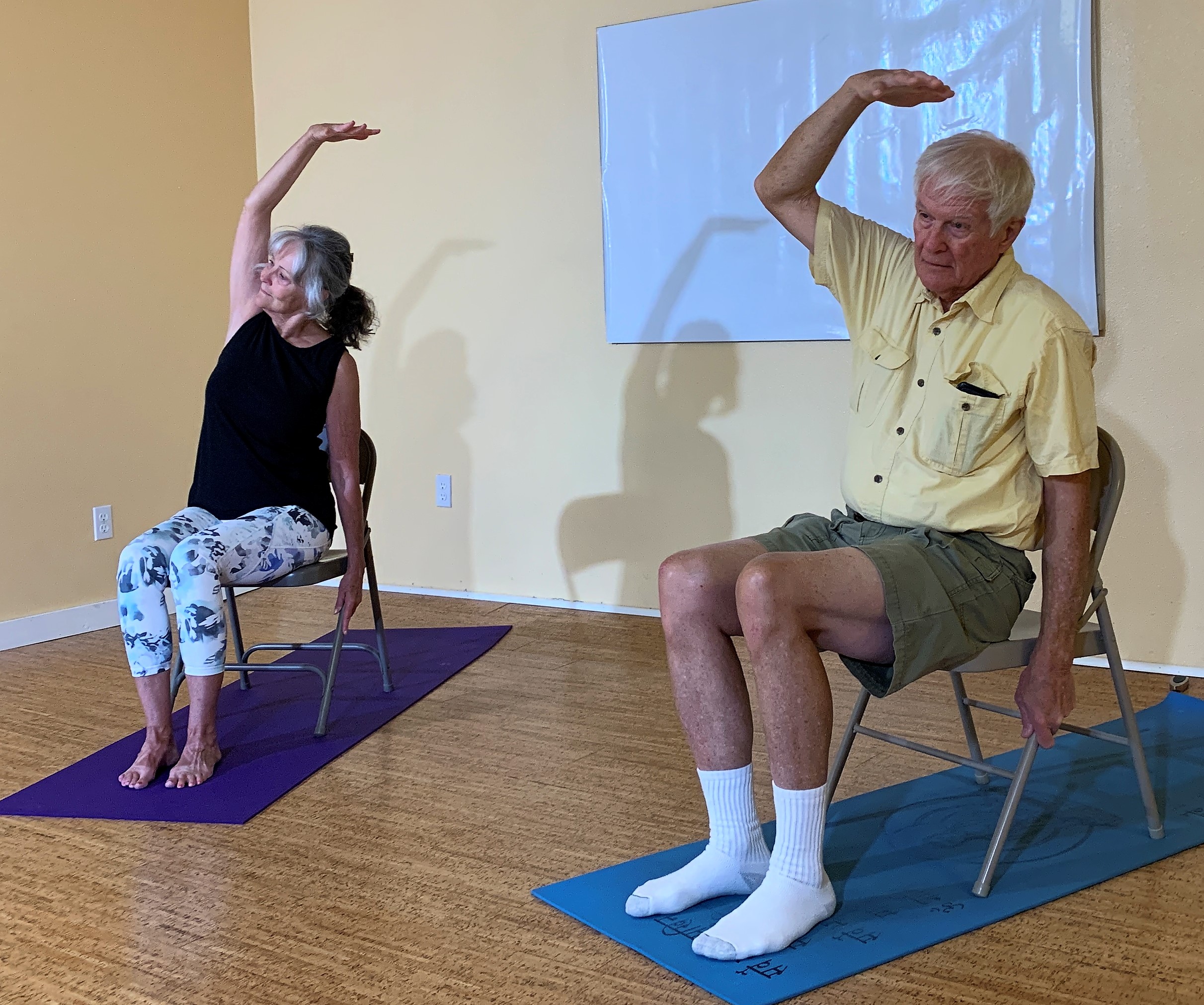
Now that the spine is lubricated, it is time to bring in more circulation to the periphery.
Shoulder Rolls Forward and Back
Place fingers on head of arm bones and inhale shrug shoulders up, lift your elbows forward. Exhale widen elbows out to the side as you squeeze shoulder blades together and down. Repeat 3-5 breaths. Change directions for 3-5 breaths.
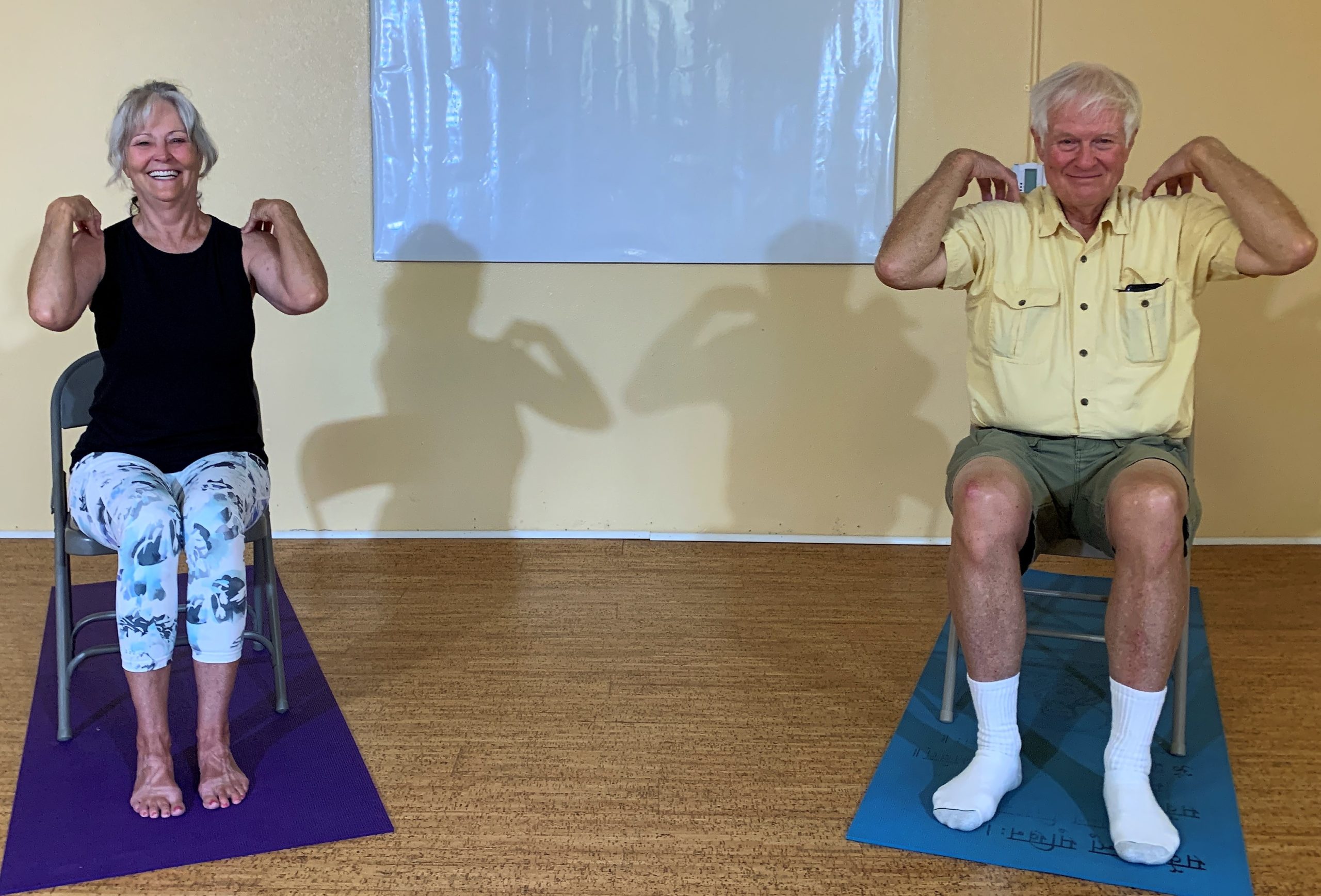
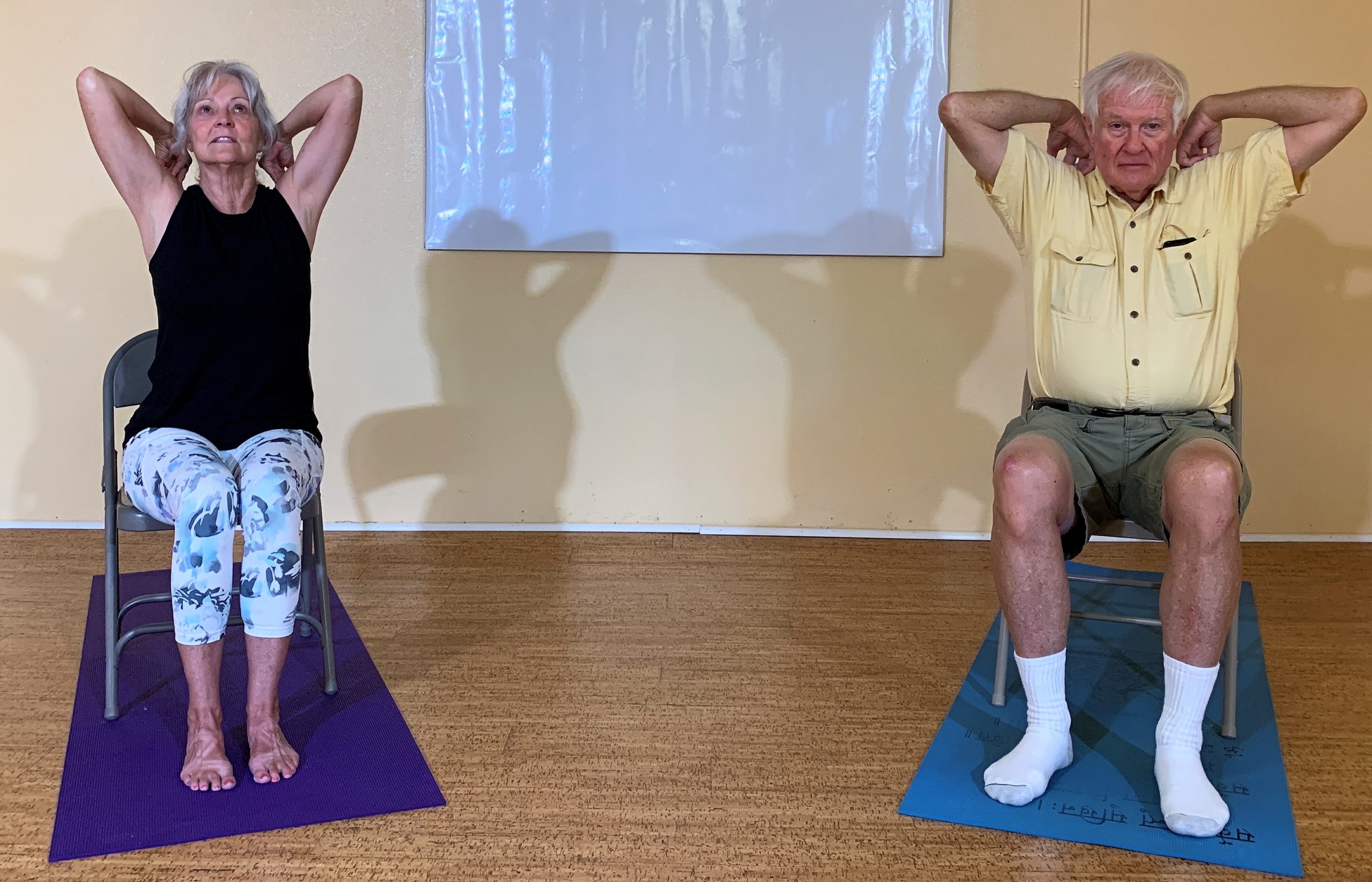
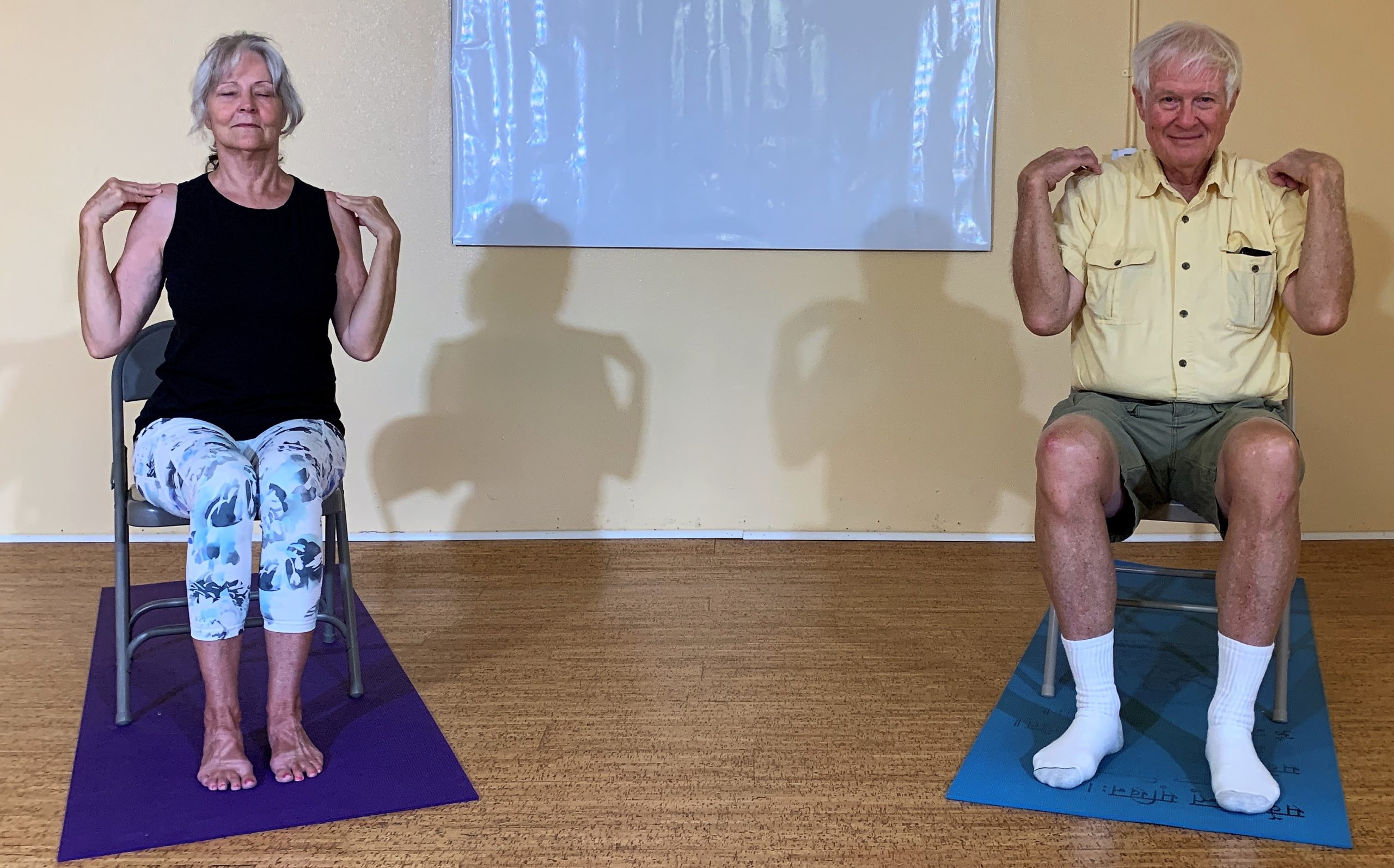
Wrists
Interlace fingers in front of you. Keep the palms together and begin to rotate hands in one direction to create a circle. Go slow for 2- 3 breaths then speed it up for 2-3 more breaths. Change the interlacing of your fingers to the “weird way” to hold hands with yourself and repeat circling the other direction.

Hips/Ankles
Sit up tall and gather your right knee towards your chest with your right hand. Begin to rotate your knee the right to create circles. After 3-5 rotations, reverse the circle direction. Then place your right thigh on top of your left thigh. Begin to rotate your ankle in a clockwise circle for 3 breaths then counterclockwise. Keep the shape of the legs and begin to squeeze the outer shins towards each other, maybe tuck the right foot behind the left calf for Garudasana (eagle pose). You will see diverse positions in this pose for many reasons. Take this time to give everyone permission to let the legs cross comfortably and squeeze whatever shape they can make. Take your left arm on top of your right and hug the outer arm pits with each hand (they may only be able to hold opposite elbows instead of armpits). Lift your elbows to shoulder height. 3-5 breaths. Repeat on the left side starting with hip circles.


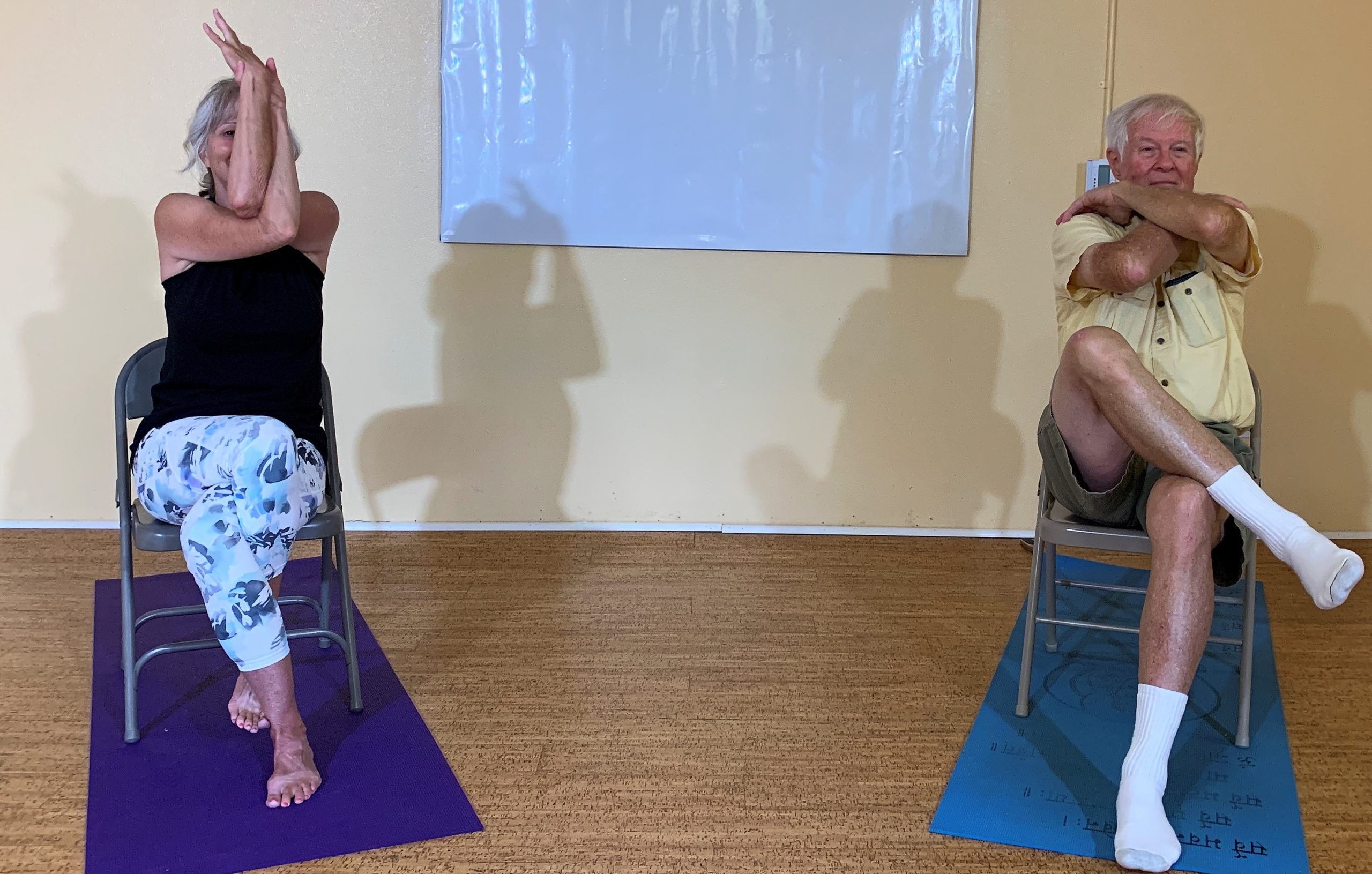
Warrior 2 Seated
Shift to the right side of your chair. Turn you right knee and foot to the right as you sit into your right thigh and sitting bone. Extend your left leg behind you by squeezing your quadricep and turn your left foot sideways. Open your arms to the side and turn your shoulders and belly to face the side. Hold 5-7 breaths. You can do reverse warrior 2 and side angle as a variation. Repeat on the left side.

Uttkatasana
Bring your feet about hip distance apart. Draw the heels back just slightly behind the knees and pretend to spread the floor with your feet without moving them anywhere. Inhale press your hands in Anjali mudra and keep your shoulders on your back, eyes forward. Exhale hinge slightly at the hips press into your heels and hover your hips above the chair while the chest and eyes remains up (encourage students to use hands if necessary or just try to lift without coming out of the chair). Inhale sit back down; exhale repeat 3-5 times. On the last one, stay hovering for 3 breaths then rise to stand on an inhale.
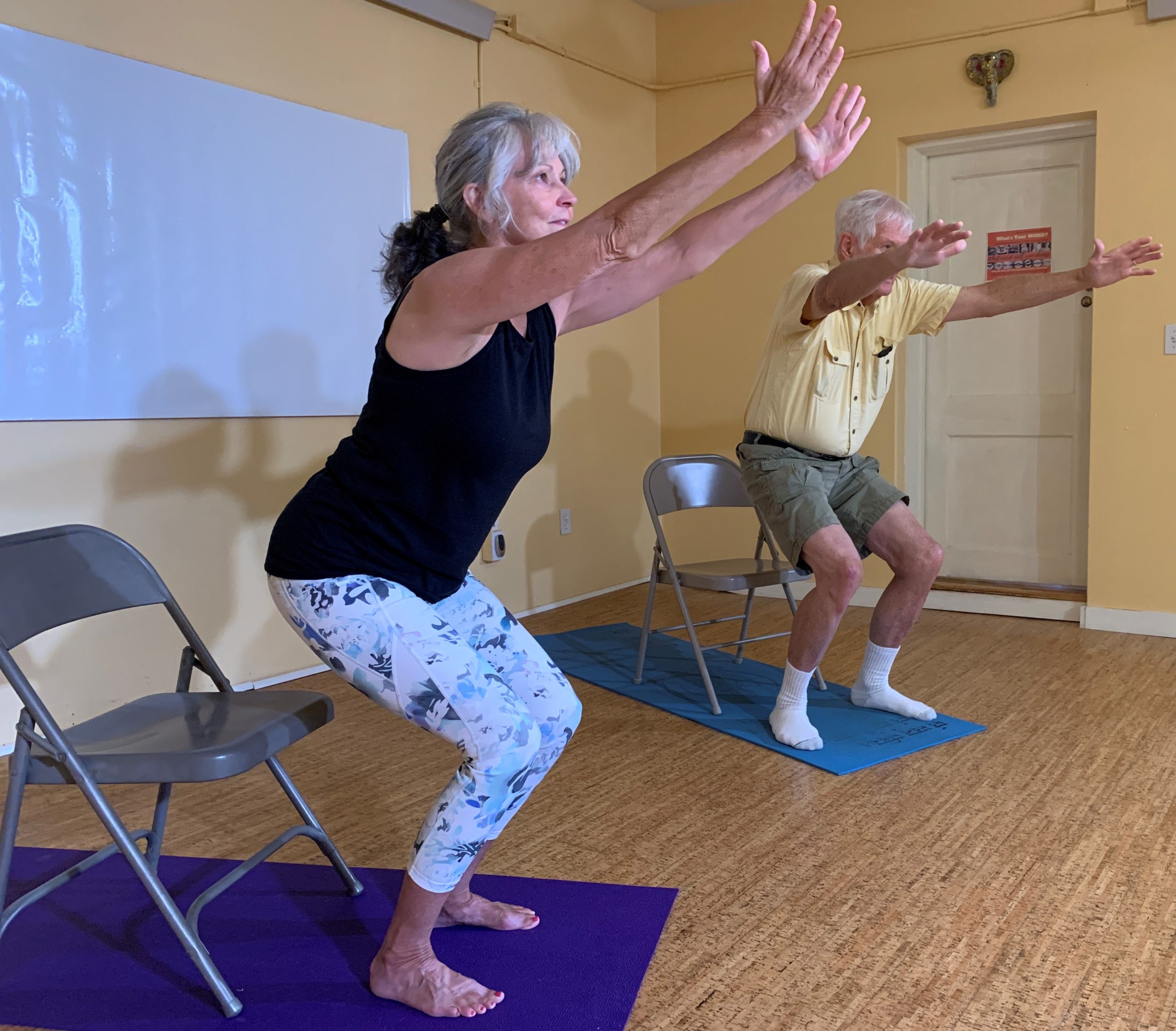
Down Dog
Once standing have the students turn the chair so they can place their hands on the seat of the chair and step their feet back into down dog. Encourage bent knees and wide feet as well as bum higher than head. This often takes a “mini workshop” to get them into the correct position. I demonstrate technique that shows poor alignment and proper alignment and the explain the myriad of benefits of down dog. Hold 3 -5 breaths.

Plank
Once in down dog you can move forward to plank. Inhale to plank, exhale back to down dog. I always give the option to stay in dog. I encourage inner armpits forward and neck is free from tension. You can also hold plank once they get stronger or just pulse back and forth from plank to dog. Move for 5-10 breaths. Finish in down dog and walk your feet towards your chair. Lengthen the spine in ½ lift. Take hands to hips, elbows point to the sky and with a strong belly and flat back rise.

Figure 4
Turn the chair around and take a seat. Flex your right foot and place it on top of your left knee to create a figure 4 shape. Many bodies need extra support so to modify take your hands to the outside of the right shin and lift slightly. Do not let the right foot go to sleep and sickle. Wake it up and that helps protect the knee in this shape. Widen the right knee away from the right shoulder and hold 3-5 breaths. Repeat on the left side.
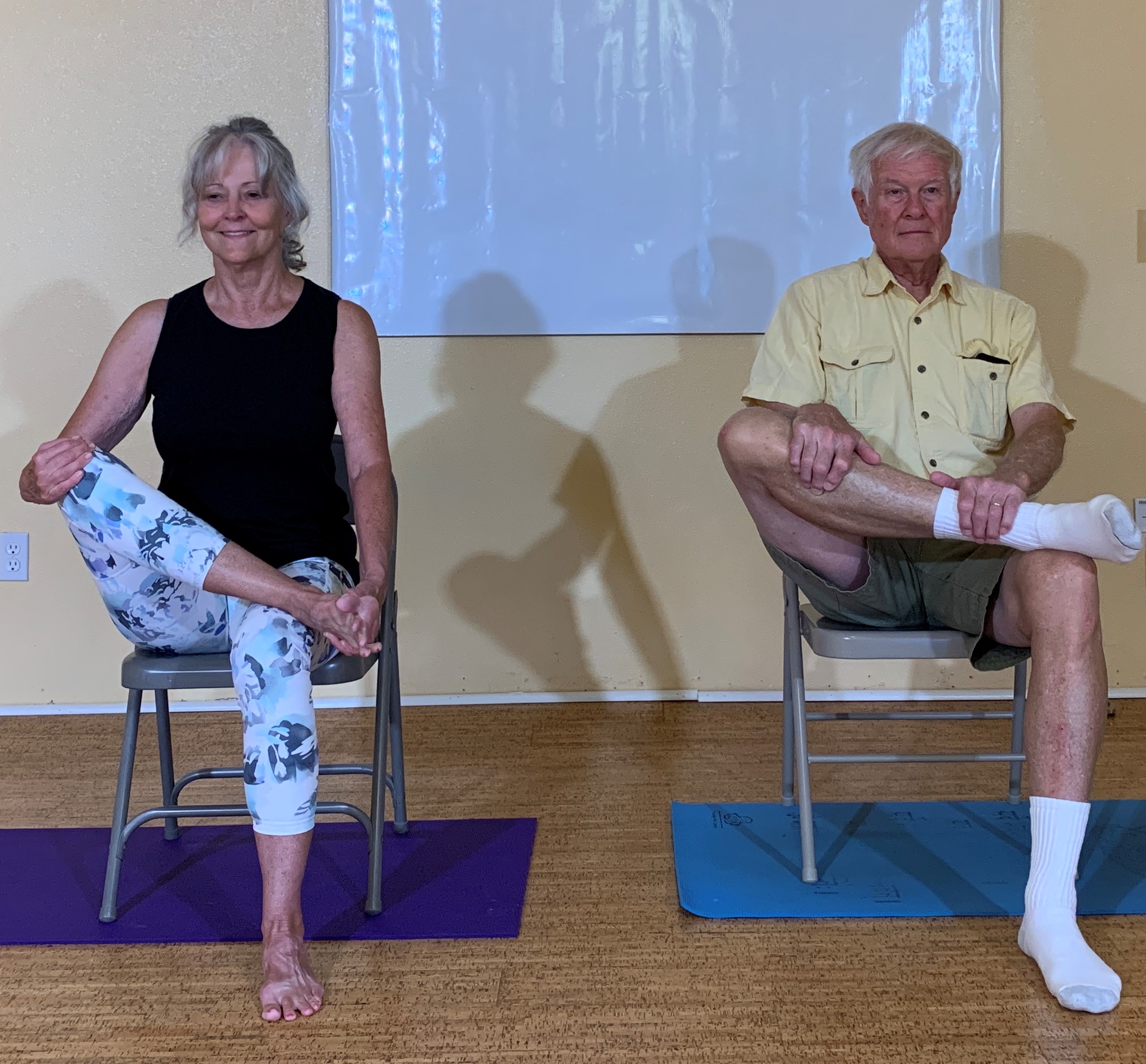
Savasana
You can incorporate ½ sun salutes here if you have a little extra time, otherwise lie back into the chair and find a comfortable resting pose. If they can get up and down off the floor, I demonstrate legs on the chair for savasana. Conscious breath continues for 1-2 minutes with guidance then let everything go for 2 minutes.












